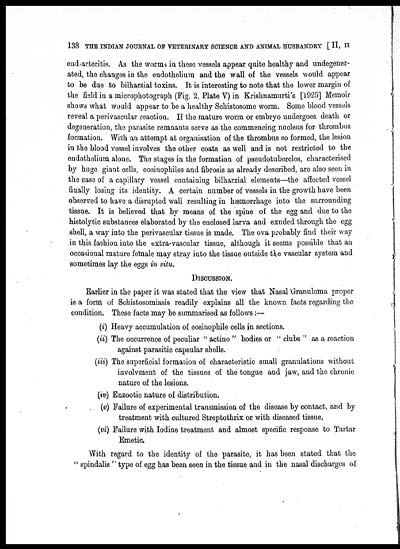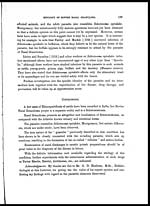Medicine - Veterinary > Veterinary colleges and laboratories > Indian journal of veterinary science and animal husbandry > Volume 2, 1932 > Original articles > Etiology of bovine nasal granuloma
(164) Page 138
Download files
Individual page:
Thumbnail gallery: Grid view | List view

138 THE INDIAN JOURNAL OF VETERINARY SCIENCE AND ANIMAL HUSBANDRY [ II, II
end-arteritis. As the worms in these vessels appear quite healthy and undegener-
ated, the changes in the endothelium and the wall of the vessels would appear
to be due to bilharzial toxins. It is interesting to note that the lower margin of
the field in a microphotograph (Fig. 2, Plate V) in Krishnamurti's [1925] Memoir
shows what would appear to be a healthy Schistosome worm. Some blood vessels
reveal a perivascular reaction. If the mature worm or embryo undergoes death or
degeneration, the parasite remnants serve as the commencing nucleus for thrombus
formation. With an attempt at organisation of the thrombus so formed, the lesion
in the blood vessel involves the other coats as well and is not restricted to the
endothelium alone. The stages in the formation of pseudotubercles, characterised
by huge giant cells, eosinophiles and fibrosis as already described, are also seen in
the case of a capillary vessel containing bilharzial elements—the affected vessel
finally losing its identity. A certain number of vessels in the growth have been
observed to have a disrupted wall resulting in hæmorrhage into the surrounding
tissue. It is believed that by means of the spine of the egg and due to the
histolytic substances elaborated by the enclosed larva and exuded through the egg
shell, a way into the perivascular tissue is made. The ova probably find their way
in this fashion into the extra-vascular tissue, although it seems possible that an
occasional mature female may stray into the tissue outside the vascular system and
sometimes lay the eggs in situ.
DISCUSSION.
Earlier in the paper it was stated that the view that Nasal Granuloma proper
is a form of Schistosomiasis readily explains all the known facts regarding the
condition. These facts may be summarised as follows:—
( i) Heavy accumulation of eosinophile cells in sections.
( ii) The occurrence of peculiar " actino " bodies or " clubs " as a reaction
against parasitic capsular shells.
( iii) The superficial formation of characteristic small granulations without
involvment of the tissues of the tongue and jaw, and the chronic
nature of the lesions.
( iv) Enzootic nature of distribution.
(v) Failure of experimental transmission of the disease by contact, and by
treatment with cultured Streptothrix or with diseased tissue.
( vi) Failure with Iodine treatment and almost specific response to Tartar
Emetic.
With regard to the identity of the parasite, it has been stated that the
" spindalis " type of egg has been seen in the tissue and in the nasal discharges of
Set display mode to: Large image | Zoom image | Transcription
Images and transcriptions on this page, including medium image downloads, may be used under the Creative Commons Attribution 4.0 International Licence unless otherwise stated. ![]()
| Permanent URL | https://digital.nls.uk/75227691 |
|---|
| Description | Covers articles from 1932. |
|---|




